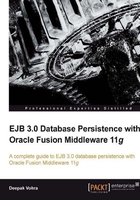
EJB (Enterprise JavaBeans) 3.0 entity beans is a commonly used database persistence technology. EJB 3.0 has simplified the development of EJBs with an annotations-based API that does not require remote/local interfaces, home/local home interfaces, or deployment descriptors. Developing entity EJBs requires an application server and a relational database, and optionally a Java EE IDE to simplify the process of development. The objective of the JSR-000220 Enterprise JavaBeans 3.0 specification (http://jcp.org/aboutJava/communityprocess/final/jsr220/index.html) is to improve the EJB architecture by reducing its complexity from the developer's point of view. EJB 3.0 has introduced some new features, which include support for metadata annotations, default values for configuration, simplified access to environment variables, simplified session and entity beans, interceptors, enhanced support for checked exceptions, and elimination of callback interfaces.
A number of books are available on EJB 3.0, but none cover EJB 3.0 on the Oracle Fusion Middleware (11g) platform. Most of the EJB 3.0 books are GlassFish server based, which has only 10percent of the application server market. Welcome to EJB 3.0 Database Persistence with Oracle Fusion Middleware 11g, a book that will teach you how to leverage EJB 3.0 persistence on Oracle Fusion Middleware 11g. Oracle Fusion Middleware 11g includes many components such as the SOA/BPM Suite, WebCenter, and Oracle Identity Management. All of these components run on Oracle Weblogic Server 11g. The main development tool (IDE) for Oracle Fusion Middleware is Oracle JDeveloper. In respect of EJB 3.0, JDeveloper provides wizard support to reverse engineer database tables as EJB 3.0 entity beans. JDeveloper 11g also provides a wizard for creating session beans. The JPA persistence provider used in JDeveloper 11g is the EclipseLink persistence provider. JDeveloper comes with its own embedded/integrated Weblogic Server instance, which makes it very easy to develop and test within the one environment. We shall be using the embedded WebLogic Server 11g in some of the chapters and the standalone WebLogic Server in others.
The objective of the book is to discuss the support of EJB 3.0 database persistence in Oracle Fusion Middleware 11g. While JDeveloper is the main Java IDE used in the book, one of the chapters leverages the Oracle Enterprise Pack for Eclipse. The book covers all aspects of EJB 3.0 database persistence including:
- Creating EJB 3.0 entity beans from database tables
- Creating session bean façades for entity beans
- Entity beans with session beans
- Creating EJB 3.0 entity relationships
- Creating JSF and ADF Faces user interfaces (UIs) on top of EJB 3.0 database persistence
- Using EJB 3.0 database persistence in combination with Ajax and web services
In Chapter 1, What's New in EJB 3.0, we discuss the new features in the EJB 3.0 specification, such as support for metadata annotations, default values for configuration, simplified session and entity beans, and enhanced support for checked exceptions.
In Chapter 2, Converting an EJB 2.0 Entity to an EJB, we convert an example EJB 2.0 entity bean to an EJB 3.0 entity bean. We also generate the session bean façade for the EJB 3.0 entity bean. XSLT transformation is used for converting the EJB 2.0 entity bean to an EJB 3.0 entity bean.
In Chapter 3, EclipseLink JPA Persistence Provider, we discuss the JPA framework and the EclipseLink persistence provider.
In Chapter 4, Building an EJB 3.0 Persistence Model with Oracle JDeveloper, we discuss EJB 3.0 database persistence with JDeveloper 11g, WebLogic Server 11g, and Oracle Database 10g. We create an EJB 3.0 entity bean from a database table, create a session bean façade, and finally create a JSP test client. Using the test client, we create, retrieve, and delete entity bean instances.
In Chapter 5, EJB 3.0 Persistence with Oracle Enterprise Pack for Eclipse, we discuss the same example we covered in Chapter 4, but with the Oracle Enterprise Pack for Eclipse, WebLogic Server, and the open source MySQL database, which has been acquired by Oracle.
In Chapter 6, EJB 3.0 with ADF Faces UI, we discuss using an ADF Faces client for EJB 3.0 database persistence. We create an entity bean using data input from an ADF Faces user interface (UI). Subsequently, we find an entity bean instance using data input from an ADF Faces UI.
In Chapter 7, Creating EJB 3.0 Entity Relationships, we discuss EJB 3.0 entity relationships using, as an example, three entity beans that have inter-relationships. We also discuss the significance of a fetch strategy.
In Chapter 8, EJB 3.0 Database Persistence with Ajax in the UI, we discuss EJB 3.0 database persistence in combination with Ajax in the user interface (UI). We demonstrate data validation and autocompletion with Ajax.
In Chapter 9, Using JSF with Entity Relationships, we discuss adding JSFs to EJB 3.0 database persistence to create and persist entity bean instances that have entity relationships between them.
In Chapter 10, Creating an EJB 3.0 Web Service, we create a JAX-WS Web Service from an EJB 3.0 entity bean, create a web service client, package and deploy the web service to WebLogic Server, and test the Web Service using the WebLogic console.